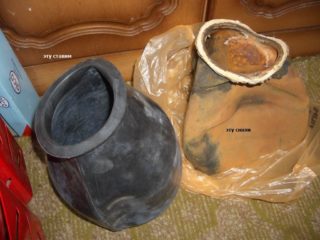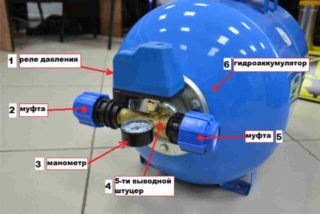When to change the parts of the accumulator, the unstable operation of the pump or a leak will tell you. If the equipment has been operating in a damp room for a long time, and the storage tank is made of steel, it is highly likely that sooner or later it will rust. To replace the accumulator in the pumping station, you will need to remove and disassemble it, after draining the water and disconnecting the pump from the power supply.
When is it time to change the accumulator
- water pressure;
- air pressure around the pear.
If the relay is set to 3 atmospheres, then 1 atmosphere is given by the air in the case, and 2 atmospheres by the liquid itself. Therefore, it is periodically necessary to measure the air pressure in the housing, if suddenly the pumping station began to work longer than usual or turn on more often. To check if the membrane has burst, you just need to push on the nipple: if water flows, then it's time to change the pear. It happens that the ring that holds the membrane in place becomes unusable, it is responsible for the tightness of the system.
If the cause of damage to the pear is primary, the problem will soon affect the integrity of the tank, because the liquid will flow into it continuously and rust will form inside.
How to identify a breakdown from home
In the event of a breakdown, the water in the tap will flow unevenly - either with pressure, or in a thin stream. If you hear the sound of a working station from home, you can determine that it turns on more often and works longer. This happens because the engine cannot gain the required power to turn off the relay - until the sensor is triggered, the engine will run. Such a constant mode cannot be allowed, since the device may simply burn out if it does not have overheating protection installed.
Preparation for repair work
In order to more accurately determine the cause of the breakdown of the pumping station, namely the accumulator or its parts, this unit is removed and disassembled. Before that, the water is drained:
- the station is turned off;
- the hole through which water enters the tank is blocked;
- open the taps in the house and drain all the water.
All repair work is best done in the light. For this, the container is taken out into the street and the flange connections are untwisted. Inside you can find a torn membrane that needs to be replaced, find cracks in the body or a broken ring holding the neck of the pear.
Replacement parts can be purchased from a service center or similar from other brands. The main thing is to fit in size and volume.
Stages of work

After disassembling and preparing spare parts, you need to rinse the new membrane, dry the metal container, if it does not require repair. If deposits have accumulated inside - lime or rust - they must be removed with sandpaper or a wire brush, then rinsed and dried.
When replacing the membrane, the main focus is on the seat so that the rubber lies flat on it. After that, the pear is fixed and the tank is reassembled. To check the tightness, air is pumped into the housing and kept for a day, after which it is measured again. If there are no losses, then it was only a matter of the membrane.The accumulator can be installed back and connected to the supply pipes.
If a whole membrane was found during disassembly, this means that water interruptions are associated with a crack in the case, through which air escapes. The breakage was detected on time, if the rubber is still intact, because over time it stretches and breaks more and more.
To repair the case, you will need a welding machine or glue solution. Cold welding is more reliable, since the glue under pressure sooner or later leaves and the problem reappears.
Preventive measures
The accumulator membrane breaks down faster if there are frequent temperature fluctuations. For cold water supply, a pear is made of rubber, for hot water - from a special material, which, according to the manufacturers, can withstand heating up to 100 degrees for 5 years. If the operating conditions are not followed, the rubber will not withstand 5 years.
The rubber bulb also does not tolerate frequent sudden changes in pressure, from this it wears out faster. Strong compression, which occurs under excessive pressure in the tank, leads to deformation of the material and its cracking.
It is important to strike a balance between the maximum pressure in the membrane and the air pressure, which should not exceed 2 atmospheres. To do this, periodically connect a pressure gauge to the spool and check how much air is inside. If necessary, you can pump up with a simple bicycle or machine pump.









